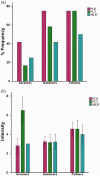The role of insula-cerebellum connection underlying aversive regulation with acupuncture
- PMID: 29921161
- PMCID: PMC6077882
- DOI: 10.1177/1744806918783457
The role of insula-cerebellum connection underlying aversive regulation with acupuncture
Abstract
Acupuncture at pericardium 6 (PC6) shows a consistently positive efficacy in nausea response suggested by consensus expert guidelines. Nausea encompasses aversive symptom as well as strong emotional components. Disgust is a subjective emotion of uneasy commonly accompanying with a physiological response that is accompanied by strong visceral sensations (e.g., nausea). Understanding the brain circuitry by which acupuncture influences the disgust emotion may further elucidate the modulation effect of acupuncture on aversive experience. In the present study, a well-established aversive conditioning model on healthy subjects was combined with acupuncture intervention at PC6, as well as different acupoints (both local PC7 and distant GB37) as separate controls, to investigate the brain network involved aversive regulation with acupuncture; 48 healthy subjects were enrolled and randomized into four parallel groups: group 1 received disgust-induced (DI) stimuli only; groups 2, 3, and 4 received acupuncture at three single acupoints separately prior to the DI. Disgust sensations were rated at baseline and following disgust stimuli. Acupuncture PC6 can induce significant attenuations in disgust sensations than that of no intervention and acupuncture at other acupoints. Neuroimaging further showed that increased causal interaction strength between the cerebellum (nodulus) and insula can predict greater attenuations in aversive experiences. We also found evidence for radical reorganizations of local stronger casual interaction patterns to disgust-induced brain responses targeted by acupuncture at different acupoints. This study provided the brain substrate for acupuncture on aversion modulation. The coupling between the cerebellum (nodulus) and insula supported interoception system and vestibular control which provided the specific neural basis.
Keywords: Acupuncture; antiemetic effect; casual interaction; disgust regulation; insula-cerebellum; interoception system; vestibular control.
Figures





Similar articles
-
Neural specificity of acupuncture stimulation at pericardium 6: evidence from an FMRI study.J Magn Reson Imaging. 2010 Jan;31(1):71-7. doi: 10.1002/jmri.22006. J Magn Reson Imaging. 2010. PMID: 20027574
-
Investigation of acupoint specificity by multivariate granger causality analysis from functional MRI data.J Magn Reson Imaging. 2011 Jul;34(1):31-42. doi: 10.1002/jmri.22585. J Magn Reson Imaging. 2011. PMID: 21698705
-
Modulation of cerebellar activities by acupuncture stimulation: evidence from fMRI study.Neuroimage. 2004 Jun;22(2):932-40. doi: 10.1016/j.neuroimage.2004.02.017. Neuroimage. 2004. PMID: 15193624
-
Effects of acupuncture needling with specific sensation on cerebral hemodynamics and autonomic nervous activity in humans.Int Rev Neurobiol. 2013;111:25-48. doi: 10.1016/B978-0-12-411545-3.00002-X. Int Rev Neurobiol. 2013. PMID: 24215916 Review.
-
[Insula and disgust].Rinsho Shinkeigaku. 2010 Nov;50(11):1000-2. doi: 10.5692/clinicalneurol.50.1000. Rinsho Shinkeigaku. 2010. PMID: 21921543 Review. Japanese.
Cited by
-
Acupuncture therapy on postoperative nausea and vomiting in abdominal operation: A Bayesian network meta analysis.Medicine (Baltimore). 2020 Jun 5;99(23):e20301. doi: 10.1097/MD.0000000000020301. Medicine (Baltimore). 2020. PMID: 32501976 Free PMC article.
-
Revealing Goal-Directed Neural Control of the Pharyngeal Phase of Swallowing.Dysphagia. 2025 Jun;40(3):528-540. doi: 10.1007/s00455-024-10758-3. Epub 2024 Oct 10. Dysphagia. 2025. PMID: 39387924 Free PMC article. Review.
-
Acupuncture mechanism studies employing task-based fMRI: a scoping review protocol.Syst Rev. 2022 Jun 22;11(1):128. doi: 10.1186/s13643-022-02007-1. Syst Rev. 2022. PMID: 35733154 Free PMC article.
-
A multicenter cross-sectional study to elucidate altered resting-state functional connectivity of the insular cortex in anorexia nervosa, segmented by functional localization.Sci Rep. 2025 May 31;15(1):19118. doi: 10.1038/s41598-025-03641-0. Sci Rep. 2025. PMID: 40450148 Free PMC article.
-
Frequency-Specific Blood Oxygen Level Dependent Oscillations Associated With Pain Relief From Ankle Acupuncture in Patients With Chronic Low Back Pain.Front Neurosci. 2021 Dec 7;15:786490. doi: 10.3389/fnins.2021.786490. eCollection 2021. Front Neurosci. 2021. PMID: 34949986 Free PMC article.
References
MeSH terms
LinkOut - more resources
Full Text Sources
Other Literature Sources
Medical

